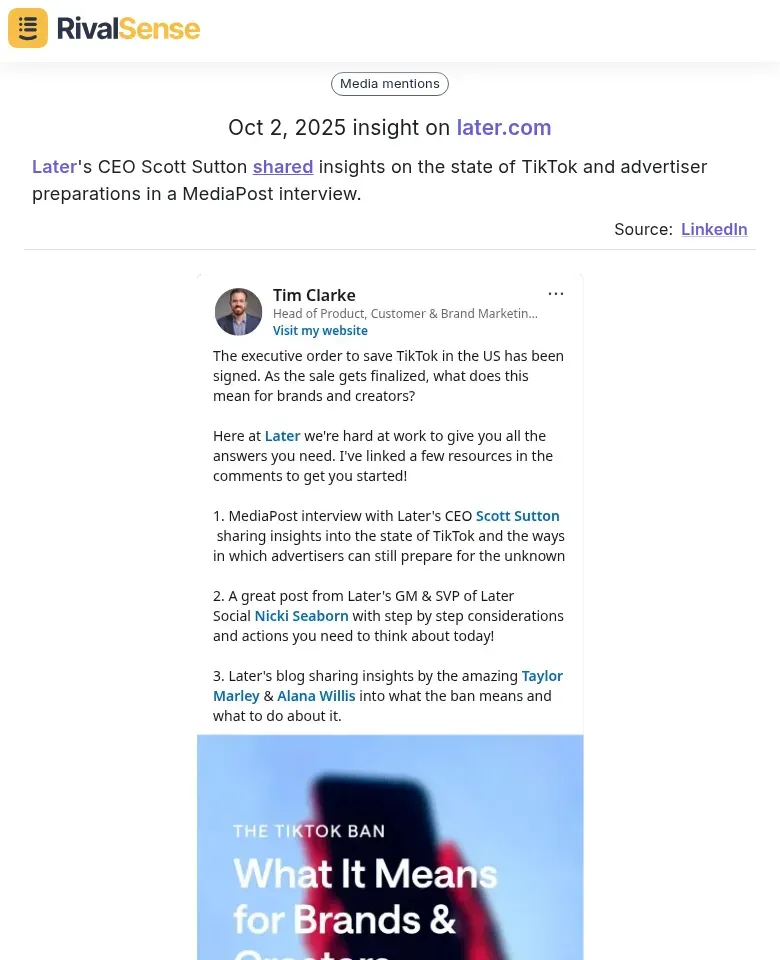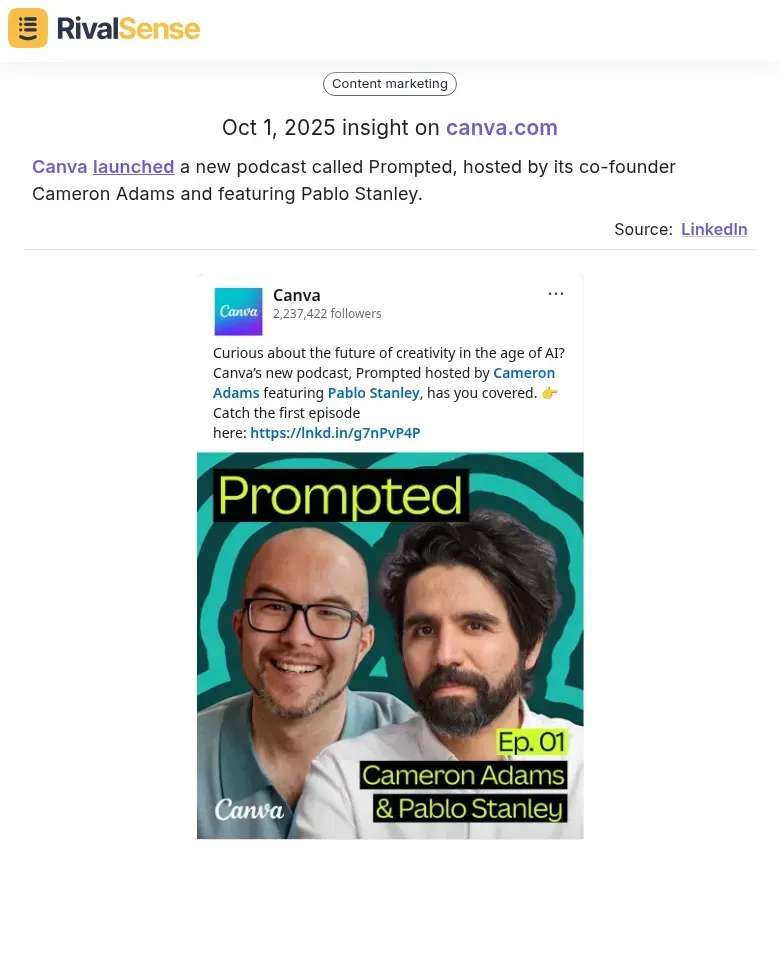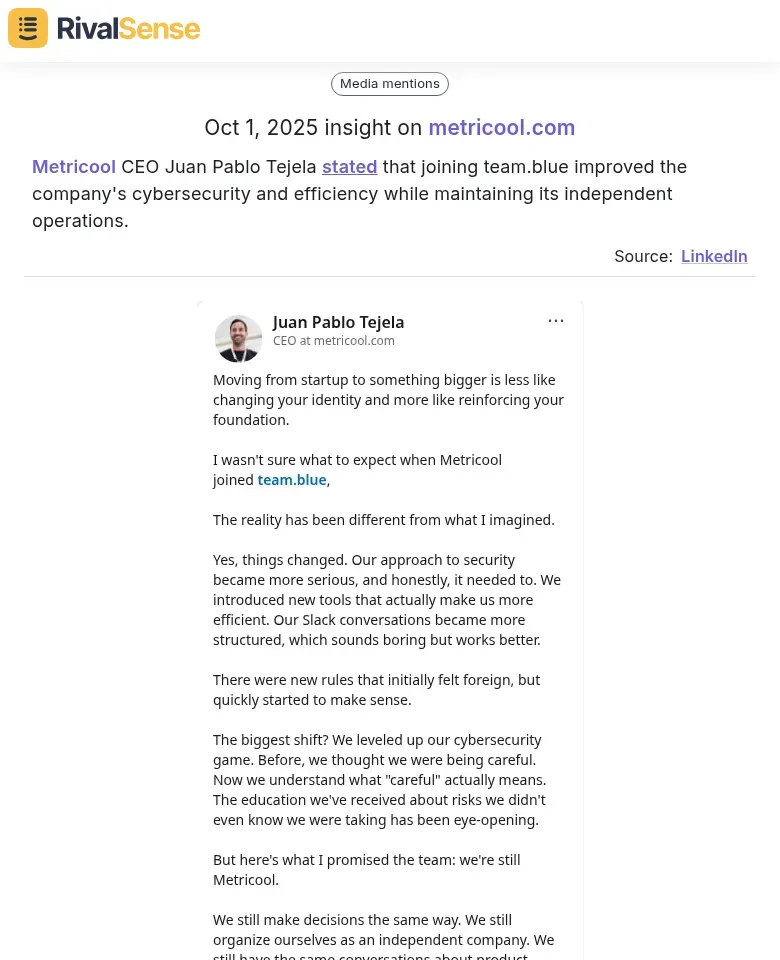Gain a Strategic Edge: Track Competitor Media Mentions and Executive Moves
In today's hyper-competitive B2B landscape, tracking competitor media mentions and executive moves isn't just about staying informed—it's about gaining a strategic edge. Competitor media intelligence reveals how rivals position themselves in the market, shape their brand narrative, and respond to industry trends. For instance, a surge in media coverage around a new product launch can signal market expansion, while negative press may highlight vulnerabilities. Simultaneously, monitoring executive moves—such as hires, promotions, or departures—provides deep insights into leadership stability, strategic shifts, and operational focus. A competitor hiring a top AI executive, for example, might indicate a pivot toward AI-driven solutions. Real-world cases show that companies leveraging these insights can anticipate market moves, refine their strategies, and seize opportunities faster.
Practical Steps:
- 🛠️ Use tools like RivalSense to automate tracking of news and social media
- 🔔 Set up alerts for key competitor names and executives
- 📊 Analyze patterns quarterly to spot trends
- 🔗 Cross-reference media mentions with financial reports for context
By integrating this intelligence, you'll transform raw data into actionable competitive advantages.
Decoding Competitor Media Mentions for Market Intelligence
Competitor media mentions reveal more than just publicity—they're a goldmine for strategic intelligence. Understanding how competitors are portrayed in the media can help you anticipate their next moves and adjust your strategy accordingly. Analyze interviews to decode messaging shifts: Are competitors emphasizing new product features, market expansion, or sustainability? For example, if a rival CEO discusses AI integration in tech interviews, it signals industry trends you can't ignore.
Why this matters: Tracking CEO interviews in major publications provides insights into strategic priorities and market positioning, helping you benchmark your own messaging and identify gaps.

Example: Later's CEO Scott Sutton shared insights on the state of TikTok and advertiser preparations in a MediaPost interview. This type of media mention highlights how competitors leverage executive thought leadership to influence industry conversations and attract advertisers.
Actionable Tips:
- 📈 Use tools like RivalSense to automate tracking of key executives and brands
- 📝 Create a monthly report categorizing mentions by theme (e.g., innovation, crises, partnerships)
- 😊 Assess sentiment (positive/negative) to gauge public perception
- 🔍 Cross-reference media spikes with competitor launches or earnings calls to anticipate market moves
This approach turns passive monitoring into proactive strategy, ensuring you're not just reacting but leading.
Learning from Competitor Content and Thought Leadership Initiatives
Competitor podcasts and content series offer a window into audience engagement strategies and innovation priorities. By analyzing their content, you can uncover what resonates with your shared target audience and adapt your own initiatives. Executive-led content, in particular, reveals company priorities and strategic focus areas that might not be publicly disclosed elsewhere.
Why this matters: Monitoring new content launches like podcasts helps you understand how competitors are investing in thought leadership to build authority and engage customers, which can inform your content strategy and differentiation efforts.

Example: Canva launched a new podcast called Prompted, hosted by its co-founder Cameron Adams and featuring Pablo Stanley. This insight showcases how competitors use multimedia content to explore emerging topics like AI and design, positioning themselves as industry innovators.
Checklist for Analysis:
- [ ] Identify episode topics and guest selection to gauge audience interests
- [ ] Track engagement metrics (e.g., download rates, social shares) to measure effectiveness
- [ ] Compare content frequency and originality against industry peers
- [ ] Note if they publish original research or are cited by reputable sources
Use this intelligence to identify gaps in your strategy and opportunities to lead rather than follow.
Strategic Insights from Executive Moves and Leadership Changes
Executive moves and leadership changes provide critical clues about a competitor's strategic direction and operational priorities. When new executives make public statements or join partnerships, they often reveal shifts in focus that can impact the market. Tracking these changes helps you anticipate competitive threats and align your resources accordingly.
Why this matters: Insights from executive statements on partnerships or operational improvements can signal growth strategies, efficiency gains, or market expansions, allowing you to proactively adjust your business plans.

Example: Metricool CEO Juan Pablo Tejela stated that joining team.blue improved the company's cybersecurity and efficiency while maintaining its independent operations. This type of executive move insight highlights how partnerships can enhance capabilities without compromising autonomy, offering lessons for your own alliance strategies.
Practical Steps:
- 📢 Monitor press releases and LinkedIn for executive appointments and quotes
- 🛠️ Use tools like RivalSense to track mentions and analyze patterns
- ✅ Create a checklist: note key roles, stated goals, and partnership details
- 🔄 Cross-reference with market trends to predict moves
This approach turns leadership noise into actionable intel, giving you an edge in anticipating competitor actions.
Practical Framework for Tracking and Analyzing Competitor Intelligence
Establishing a systematic monitoring framework is essential for turning competitor data into strategic insights. Start by identifying your key competitors and their executives, then leverage automated tools to streamline data collection. Regularly analyzing this information helps you stay ahead of market shifts and make informed decisions.
Actionable Framework:
-
Identify Key Elements:
- List top competitors and their C-suite executives
- Set up Google Alerts for company names and executive names
- Monitor LinkedIn and industry news sites for updates
-
Automate Tracking:
- Use tools like RivalSense to gather media mentions, press releases, and social media activity
- Categorize data by sentiment, frequency, and strategic importance
-
Integrate Insights:
- Hold monthly review sessions to discuss findings
- Refine your messaging, identify market gaps, or adjust product roadmaps based on competitor activity
- Maintain a shared repository for documented insights and align them with business goals
Example Table for Competitor Analysis:
| Competitor | Key Executive Moves | Media Mention Themes | Strategic Implications |
|---|---|---|---|
| Competitor A | Hired AI-focused CTO | Emphasis on sustainability | Potential pivot to green tech |
| Competitor B | CEO interviews on expansion | Podcast launches on innovation | Targeting new customer segments |
By following this framework, you'll build a repeatable process for competitive intelligence.
Conclusion: Turning Competitor Insights into Strategic Action
Transforming competitor media mentions and executive moves into strategic action requires a proactive and measured approach. Develop responsive strategies based on insights: when a rival gains positive press, amplify your unique value proposition; when they hire a key executive, assess talent gaps and strengthen your team. Consistently measuring impact through metrics like market share shifts and customer acquisition costs ensures your efforts drive tangible results.
Final Checklist for Implementation:
- 🔔 Set up automated alerts for competitor news and leadership changes
- 📈 Create a dashboard to monitor KPIs influenced by competitor activity
- 📅 Conduct quarterly strategy sessions to adjust plans based on intelligence
- 🤝 Encourage cross-functional debriefs to integrate insights across departments
This proactive approach sustains your competitive edge, turning data into decisive moves that boost business outcomes.
Ready to put these strategies into practice? Try RivalSense for free at https://rivalsense.co/ and get your first competitor report today to start gaining actionable insights from media mentions and executive moves!
📚 Read more
👉 Unlocking Strategic Insights from Competitor Personnel Moves
👉 Track Interactions with Key Accounts: 10 Practical Steps for Strategic Relationship Management
👉 Actionable Key Account Tracking Strategies for Semiconductor Design Leaders
👉 How Perplexity's Visual Electric Acquisition Alerted Competitors
👉 Real-World Examples: How Competitor Website Changes Drive Key Account Wins
